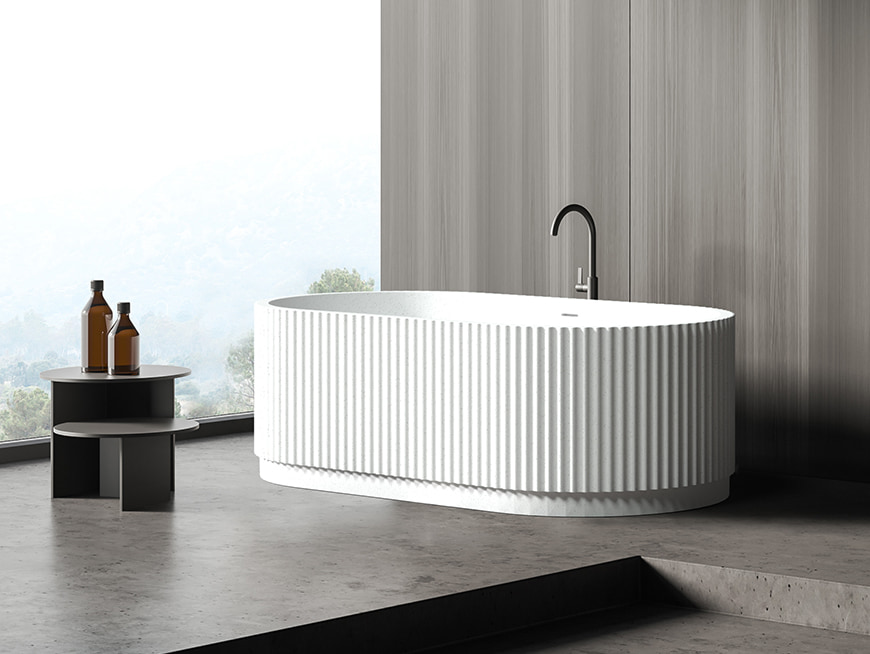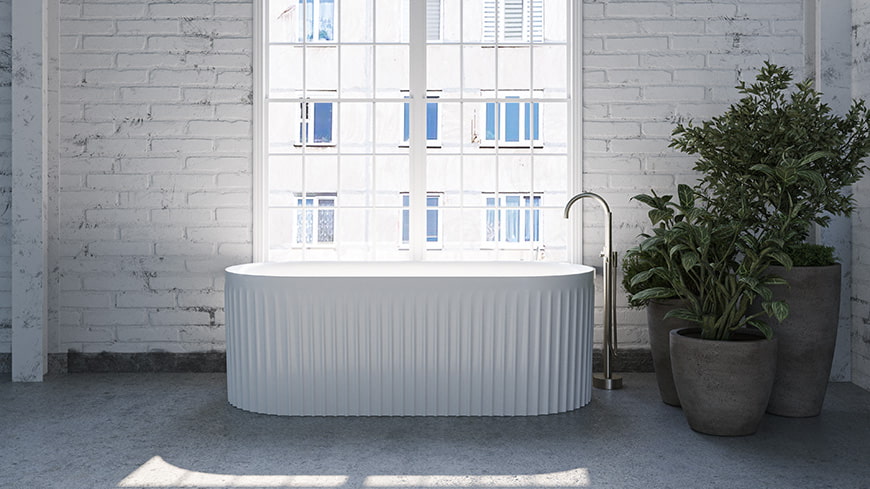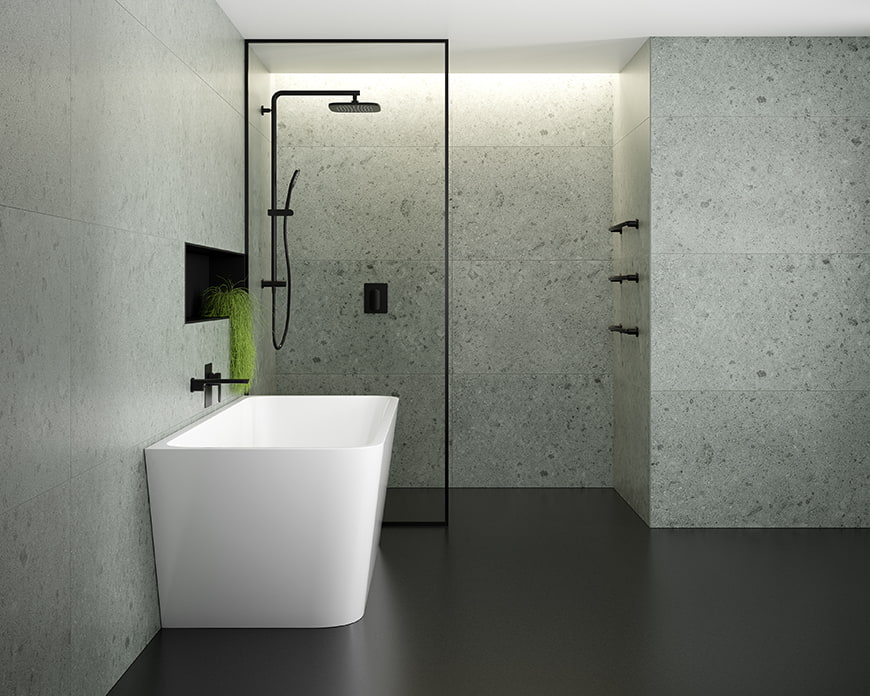Key Factors to Consider When Choosing Your Bath
Monday 29 April 2024

Choosing the perfect bath can be a task that requires careful consideration. The bath is often the centrepiece of a bathroom, and its size, style, and functionality can greatly influence the overall aesthetic and practicality of the space. From assessing the available room to setting a reasonable budget, there are several key factors one must consider.
In addition to size and budget, several other factors should not be overlooked. Material selection, for instance, is crucial as it not only impacts the look of the bath but also its durability.

Similarly, the style of the bath should harmonise with the overall design of the bathroom, whether it's modern, traditional, or a fusion of both. Ergonomics, too plays a pivotal role; a bathtub should offer comfort and easy access.
Moreover, considering the installation and maintenance requirements beforehand can save you from future hassles.
In short, choosing the perfect bath involves balancing aesthetics, functionality, and practical concerns.
7 key factors to consider when buying a bath
With this in mind, here are seven key factors you should take into consideration when choosing a bathtub:
1. Size
When it comes to buying a bath, size is an important factor to consider. You want to make sure that the bath you choose is large enough for you to comfortably fit in. You also want to make sure that the bath will fit in your bathroom without taking up too much space. Measure your bathroom and take note of any obstacles or fixtures that may interfere with the size of the bath you choose.
It's also important to remember that the bath isn't the only component in the bathroom. Allow room for other elements such as the sink, toilet, and shower, as well as enough space to move around comfortably.
It's recommended to make use of professional bathroom layout guidelines, which suggest specific distances between fixtures and a certain amount of clear floor space.
Moreover, be aware of door swing space, and consider the space required for getting in and out of the bath comfortably.
Lastly, think ahead to the installation phase. Make sure the bath can be transported through your home's doors and corridors to reach the bathroom. Neglecting to accurately measure your space can lead to serious logistical problems down the line, and may even necessitate costly returns or adjustments.
2. Design
The design of your bath is also an important consideration when making a purchase. There are a variety of designs available, from traditional clawfoot tubs to modern freestanding baths. Think about what kind of look and feel you want in your bathroom and select a design that complements the rest of your decor.

In the realm of design, you're effectively spoiled for choice. Traditional clawfoot tubs add a dash of vintage charm to your bathroom, serving as a classic and timeless feature. On the other hand, modern freestanding baths offer a clean, minimalistic touch, exuding an air of contemporary sophistication. For smaller bathrooms, corner or back-to-wall baths might be a suitable option, maximising space without compromising on comfort. If luxury is your desire, consider a whirlpool or Jacuzzi tub, transforming your bathroom into a private spa.

When choosing the design, also factor in practicality and functionality. For example, freestanding baths may require additional plumbing, while clawfoot tubs might be harder to clean around. The design should also marry well with the existing decor and architectural style of your home. Don't forget about the bath taps; they should match your chosen aesthetic.
3. Material
Baths come in a variety of materials, including acrylic, stone, and wood. Acrylic baths are lightweight and easy to clean but may not be as durable as other materials. Stone baths are beautiful but can be expensive, while wooden baths add a unique touch but require regular maintenance to keep them looking their best. Consider which material would work best for your needs before making a purchase. Parisi's StoneTec Isola Bath is beautiful, durable adn easier on the wallet than traditional stone baths.

4. Features
When shopping for a bath, consider what features you may need or want in order to make your bathing experience more enjoyable and comfortable. Some features include built-in seating, jets for hydrotherapy, air jets for bubble massage, digital temperature control systems, chromotherapy lighting systems, etc. Determine which features are most important to you before making a purchase so that you can find the right bath for your needs.
5. Cost
Cost is another important factor when it comes to buying a bathtub so it’s important to set a budget before beginning your search. There are many different types of baths available at various price points so there’s something out there for everyone’s budget range - just be sure not to sacrifice quality for cost.
When considering baths for different budgets, it's crucial to understand that the price of a bath is influenced by its material, design, size, features, and brand. At the budget end of the spectrum, you can find basic, acrylic bathtubs that are lightweight, easy to install and quite durable. These baths are typically minimalistic in design, and although they may lack premium features such as built-in seating or hydrotherapy jets, they still serve their primary purpose quite well.

For those with a mid-range budget, there is a wider variety of options available. You might consider a cast iron or a steel bath which are more robust and come in a range of designs. They may also include additional features like anti-slip surfaces and grips. Some may even offer extra features like built-in seating or a basic jet system.
On the higher end of the budget scale, stone or wooden baths could be considered. They are visually stunning and add a touch of luxury to any bathroom. These high-end baths often come with a range of premium features such as hydrotherapy jets, digital temperature control, chromotherapy lighting systems and more. Of course, with the increase in features and the use of premium materials, the price point also increases.
In essence, your budget will largely dictate what type of bath you can afford. However, it's important to remember that quality and longevity should not be overshadowed by cost. It might be worth investing a little more upfront for a bath that will resist wear and tear over the years, providing you with a better long-term investment.
6. Installation
Installation is another key factor when selecting a new bathtub - some models require professional installation while others can be installed by DIY-ers with basic plumbing skills and tools (just make sure you read all instructions carefully!). Professional installation can be costly so if you plan on doing it yourself make sure you have all the necessary tools on hand before starting the project!
7. Maintenance
Once you’ve purchased your new tub it’s important to think about how much maintenance will be required in order to keep it looking its best over time - some materials require more frequent cleaning than others so think about how often you’re willing (or able) to clean your tub before making a purchase.
Maintenance of your new bathtub isn't just about preserving its appearance, it's also crucial to prolong its lifespan and ensure it remains a hygienic and safe place to bathe. Some materials, like acrylic and fibreglass, are relatively easy to keep clean, requiring only a gentle wipe-down with a non-abrasive cleaner. Avoid using brushes or scouring pads which can scratch and dull the surface.
Stone or wooden tubs, on the other hand, need more specific care. Stone tubs need sealing periodically to prevent water absorption and staining, while wooden tubs need regular oiling to prevent the wood from drying out and cracking.
In addition, consider the cleaning requirements of any additional features your bathtub may have. For instance, bathtubs with jets need to be cleaned more frequently to prevent the buildup of bacteria and mould in the jets and pipes. The frequency of cleaning will depend on how often you use these features.
Lastly, regardless of the type of bathtub, ensuring proper water drainage after use and drying visible surfaces can help prevent the growth of mildew and keep your bathtub in optimal condition. Remember, a well-maintained bathtub not only enhances the aesthetics of your bathroom but also improves your bathing experience.
Summary
In conclusion, navigating the path to choosing the right bath might feel overwhelming at first, given the myriad of options available in the market. However, by keeping in mind these key considerations - space, functionality, quality, ease of cleaning, style, and budget - you can make an informed decision that not only meets your needs but also complements the overall look of your bathroom. Remember, the perfect bath for you is out there waiting to be found.
Bathtub FAQs
Here are some of the most frequently asked questions when it comes to choosing a bathtub:
What are the main differences between alcove, freestanding, and drop-in bathtubs?
Alcove bathtubs, typically rectangular in shape, are designed to fit into a three-wall niche, with the fourth side being the exposed front of the bathtub. They are often combined with a shower and are a common choice for smaller bathrooms due to their space-saving design. Freestanding bathtubs, on the other hand, can be placed anywhere in the bathroom as they are finished on all sides. They offer more flexibility in terms of placement and are often considered a luxury, statement item due to their standalone nature. Drop-in bathtubs, meanwhile, are designed to be 'dropped' into a pre-built deck or a surrounding structure, and only the inside of the tub is visible. This style often offers the most design flexibility, as the surrounding structure can be customised to match the overall bathroom decor.
What are the advantages and disadvantages of each type of bathtub?
Each type of bathtub comes with its own set of advantages and disadvantages. Alcove bathtubs are excellent space savers and more budget-friendly, but they may not offer the aesthetic appeal or indulgence of other types. Freestanding bathtubs serve as striking centrepieces, adding a touch of luxury to your bathroom, but they are generally more expensive and may require additional bathroom space. Meanwhile, drop-in bathtubs provide the most design flexibility as they can be inserted into a custom-built structure, but installation may be more complex and time-consuming. It's essential to weigh these factors against your specific needs and constraints when choosing a bathtub.

What materials are bathtubs typically made from?
Bathtubs are typically crafted from an array of materials, each having unique characteristics and aesthetic appeal. The most common is acrylic, admired for its lightweight, affordability, and wide range of design options. Cast iron bathtubs, though substantially heavier and pricier, are lauded for their durability and heat retention properties. Fibreglass is another lightweight, budget-friendly option, although it doesn't offer the same longevity as the aforementioned materials. Porcelain-enamelled steel tubs present a middle-of-the-road option, balancing cost and durability. High-end bathtubs might be made from luxury materials like natural stone or copper, appreciated for their distinct and opulent aesthetics, but require a substantial investment.
How do I measure my bathroom space to ensure a proper fit for a bathtub?
Measuring your bathroom space for a bathtub requires accuracy and attention to detail. Start by measuring the length and width of the area where you plan to install the tub using a tape measure. Record these dimensions precisely, as even slight inaccuracies can lead to significant problems during installation. If you're replacing an existing tub, measure its length, width, and depth to guide your choice for a new one. Also, consider the location of your plumbing fixtures. The drain, for example, can be on the left, right or at the centre, which may influence the type of bathtub you can install. Lastly, remember to assess the path through which the tub will be brought into the bathroom, ensuring it can navigate through hallways and doors.
What are some tips for choosing a bathtub that fits my style and budget?
Choosing a bathtub that fits your style and budget requires careful consideration. Firstly, define your budget to narrow down your options. You can then delve into the vast range of styles available, from classic claw-foot, drop-in, freestanding and alcove bathtubs to more contemporary designs like walk-in or whirlpool tubs. Material choice will also influence both style and price, with options such as acrylic, fibreglass, cast iron, and luxury materials like natural stone or copper. When choosing your bathtub, think about the overall aesthetic of your bathroom. Would a modern, minimalist design suit your space or does your taste lean towards traditional elegance? Keep in mind that while high-end materials offer a distinctive look, they come with a higher price tag. Opting for acrylic or fibreglass tubs can save money without compromising too much on style. Remember to consider functionality alongside aesthetics for a bathtub that you'll enjoy for years to come.